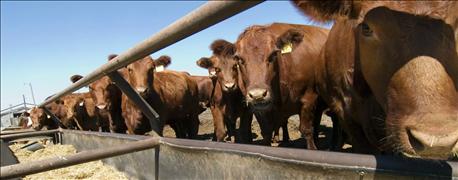
After a relatively cool and wet end to June and beginning to July, summer temperatures are on the way back, with forecasts for highs in the mid and upper 90s for the next 10 days across most of Kansas.
For cattle in feedlots, that forecast for heat comes with an added risk factor: higher humidity as a result of recent heavy rains.
From today through Thursday, all of Kansas, Oklahoma and Texas are in the "emergency" category, the greatest risk for heat stress on cattle. Maps of that forecast can be found here.

HEAT WARNING: Soaring temperatures in coming days, combined with soaked soils from recent heavy rains, put cattle in feedlots at high risk of heat stress.
Several factors, both genetic and environmental, can affect the susceptibility of cattle to heat stress. European breeds and black-hided or red-hided cattle have genetic susceptibility. Cattle that are in poor condition, have previously suffered from pneumonia have higher risk of stress, as are those that are poorly conditioned or have recently arrived at a high-risk region.
Several additional factors this week make the risk higher. Heavy rains in recent days have caused the soils at or near the feedlot to be saturated, daytime highs are forecast to be a much as 20 degrees above the risk level of 80 degrees, the high temperatures are forecast to last for a week or more and nighttime lows are forecast to be in the mid to upper 70s, well above the risk level of 70 degrees.
Individual feedlots that lie in lower areas or that have large windbreaks may have more serious conditions that the forecast in general.
The Agricultural Research Service has photos and explanations for what to watch for to monitor cattle for heat stress and recommendations on what feedlot managers can do to help cattle cope with a heat wave.
The American Angus Association also offers a video on best practices to help producers find ways to help their cattle weather heat stress.
About the Author(s)
You May Also Like






